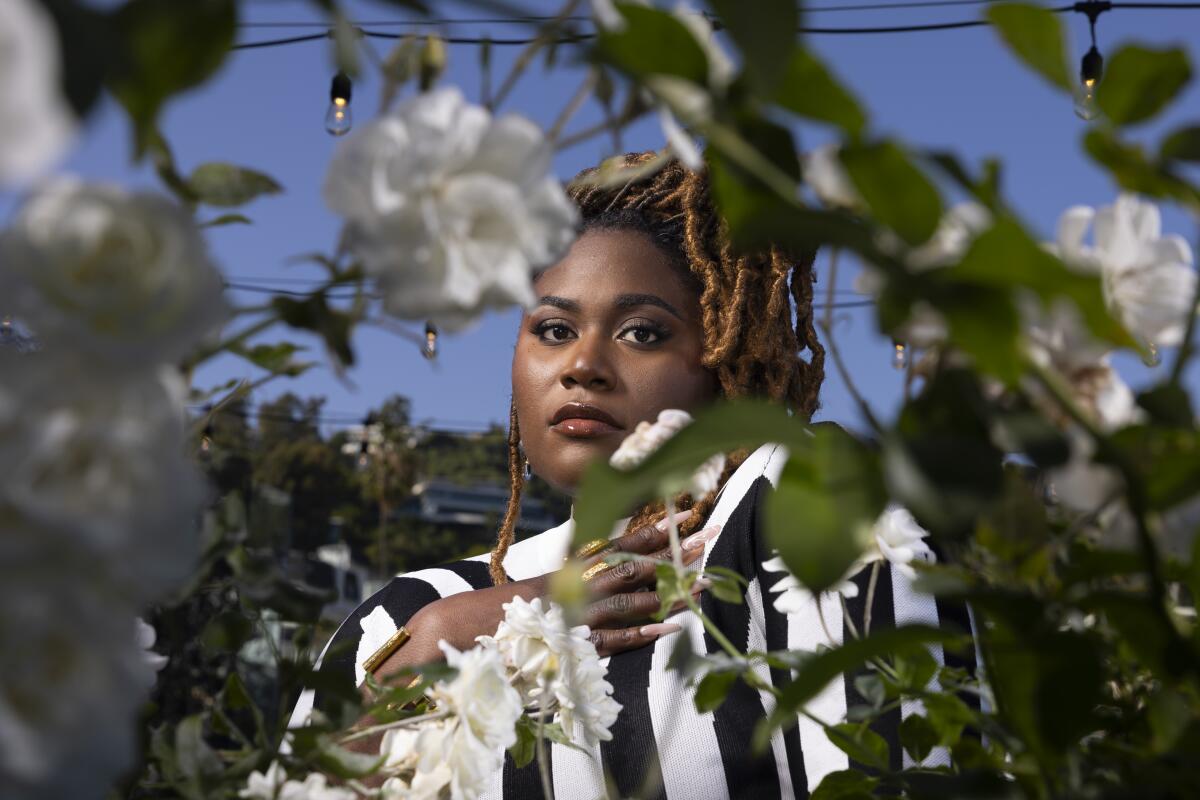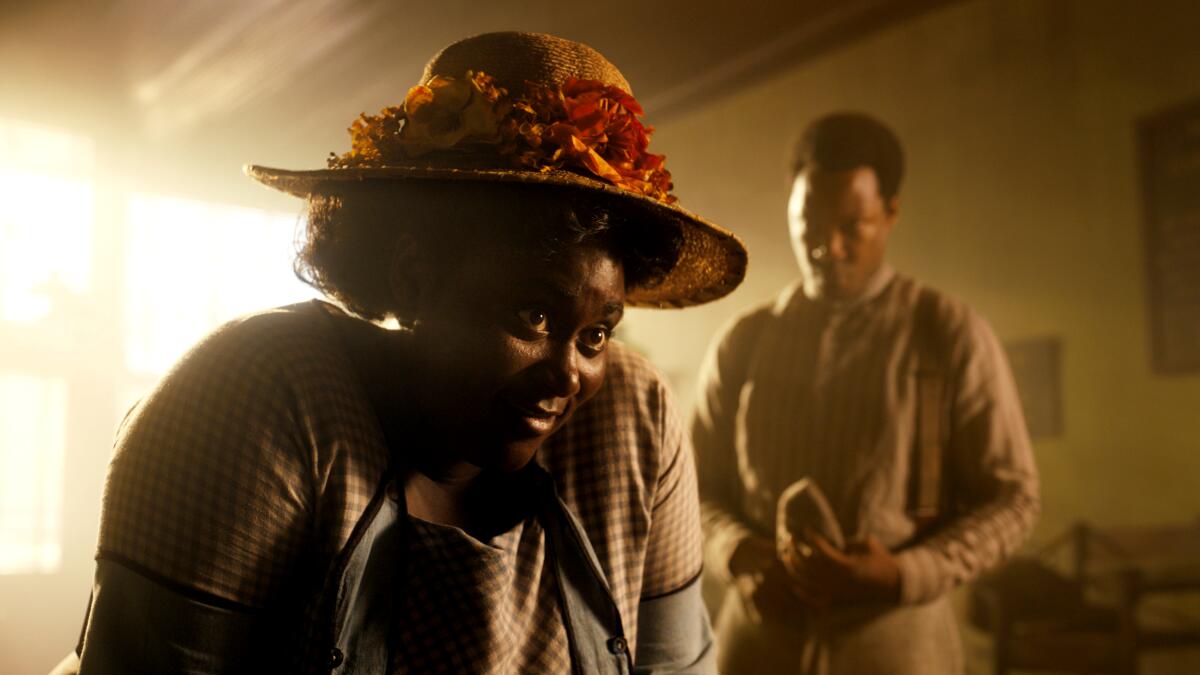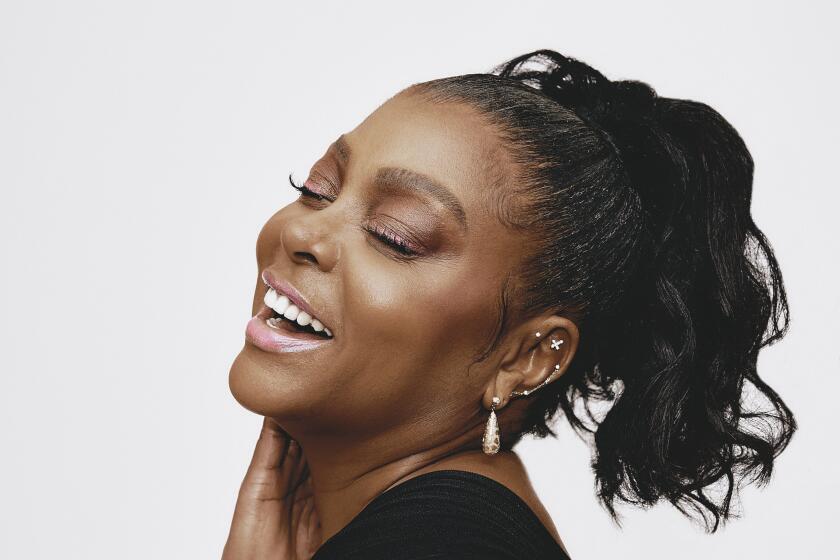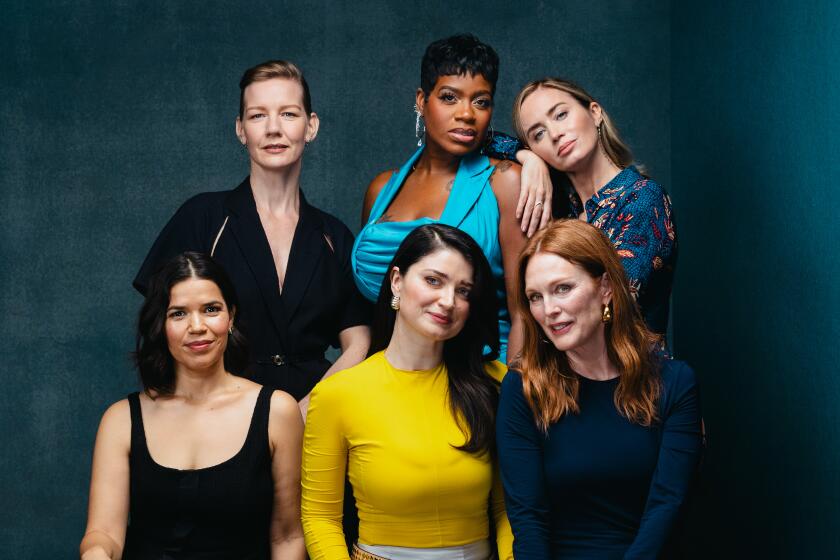How Danielle Brooks adds fuel to Oprah’s fire as Sofia in ‘The Color Purple’

- Share via
Danielle Brooks assumed that her Tony-nominated, Grammy-winning performance as the strong-willed, blunt-talking Sofia Butler in the Broadway revival of “The Color Purple” might make her an obvious front-runner when director Blitz Bazawule began casting the big-screen adaptation of the musical version of Alice Walker’s Pulitzer Prize-winning novel. Instead, she became engaged in a half-year audition process involving Zoom meetings, a self-tape of her belting out Sofia’s showstopping “Hell No!,” chemistry reads and agonizingly protracted silences from production.
“It’s called removing your ego, that’s what it’s called,” Brooks says of the experience. “I was like, ‘This is going to be a journey, and it might be a long one.’” Now with Golden Globe and Critics Choice supporting actress nominations on the books, there’s increasing talk about Brooks’ Oscar nod chances and how every time her Sofia stomps into frame, gives a piece of her mind or flashes her wraparound smile, she becomes the absolute center of the scene.
“If something is meant for you, you can’t run from it,” the actor says of turning down the role of Shug for the Broadway musical but accepting it for the film.
Not many actors get the opportunity to act in different mediums with the same role. Talk about going from commanding a black box theater to hitting marks on a film set.
When we did the John Doyle production in 2015, we had nothing. Wooden chairs on a stage. And that was so much fun, because that’s what you do in school. You figure it out. You imagine the audience goes on a journey with [you] every night, that Sofia is actually holding a baby, or a mob of white men are attacking her. But when you actually get to do it on the soil of a true plantation in Georgia, surrounded by trees and imagining, “How many women or men were hung off those trees?” to actually have a 10-pound baby in my hand that I have to take care of, to have 10, 15 men actually coming at me? Now I get to use all of my senses, to feel the hot Georgia sun on my skin, to leave [the character] Harpo on an actual wagon, not just to walk back into the wings. That changes the game.

Between Broadway and the movie, you had your first child, Freeya. Did that bring fresh insight into Sofia?
It completely opened up another well of depth for me. Sofia had six children. And to give of your body that many times? I only did it one time, and I know the fear. I had an emergency C-section. At one moment there were, like, 10 doctors rushing in to tell me that she had flat-lined. So to think of what this woman went through giving birth six times, the sacrifice, and the love that she has for her children. And not only did I have a child, I got married. So there’s the addition of knowing what it is to be in a committed relationship. With Sofia and Harpo, their whole thing is to break generational curses, to really change what it is to have to live in gender norms. And that’s what I’m striving to do with my marriage.
In 2005, your father took you to see “The Color Purple” with the original Broadway cast. Which character caught teenage Danielle’s eye?
Felicia P. Fields, who played Sofia. She looked like me. She was a plus-size woman. But it was also getting to see all these different shades of Black excellence. Coming from my little high school, I was the only Black girl chosen for the acting program. And so I always had that mentality that there was only room for one of us.
Did studying at Juilliard change your outlook?
There, it was only me and another Black girl in the class, but it opened my world to, like, “There can be two.” Then I go to “Orange Is the New Black,” and I’m like, “There can be five or six!”
Fantasia Barrino, Emily Blunt, America Ferrera, Eve Hewson, Sandra Huller, Julianne Moore offer insights into their work.
Your mother is a pastor, your father, a deacon. Is there a connection between growing up in the church and being drawn to the theater?
One hundred percent. It gave me my foundation spiritually, which is so connected to “The Color Purple,” which is all about, “God is inside of me and everyone else.” Then the element of performance is embedded in church. The choir is the ensemble. You have musicians. The program is like the Playbill. The Bible, the word, is like the script. You’re able to see what worked and what didn’t. The delivery from the pastor. You’re trying to evoke an emotion within the audience. Or when somebody prayed, just the cadences, their rhythms. How they moved people or didn’t move people. I wasn’t in church just on Sundays, it was Monday through Friday either Bible study or choir rehearsal, which is where I learned to sing. Memorizing for Easter church services taught me how to memorize lines. It was like, “This makes total sense why I love the theater so much,” because church was where I spent all my time.
You’ve always been open about how parts of your more expressive Sofia honors Oprah Winfrey’s performance in the 1985 film.
She was brilliant in that movie. There’s some iconic moments that you have to have in there. You have to have Sofia’s iconic walk when she first enters with Harpo. You have to have the [clenched] fist, because that’s symbolic of who she is — strong, resilient. It was like, “[Oprah] gave me the permission to do my thing, and I’m grateful for that.” It’s almost like she lit the fire, I just added fuel.
More to Read
From the Oscars to the Emmys.
Get the Envelope newsletter for exclusive awards season coverage, behind-the-scenes stories from the Envelope podcast and columnist Glenn Whipp’s must-read analysis.
You may occasionally receive promotional content from the Los Angeles Times.










